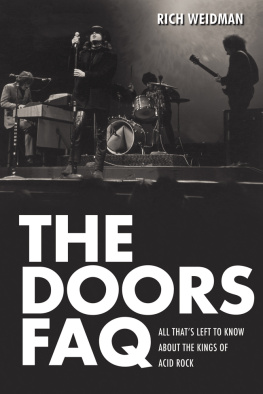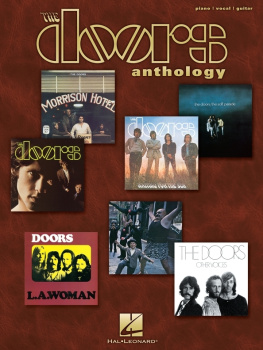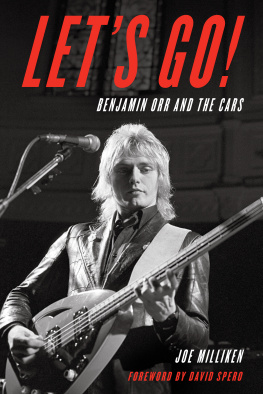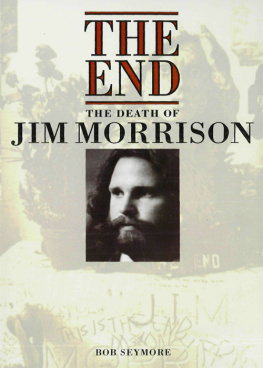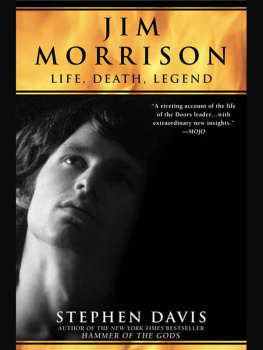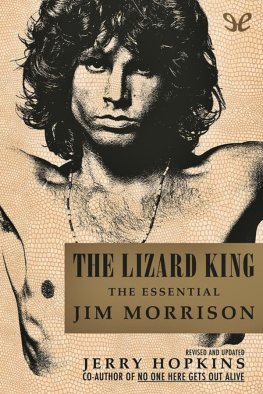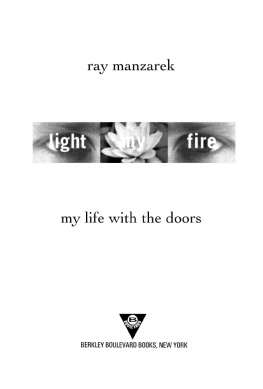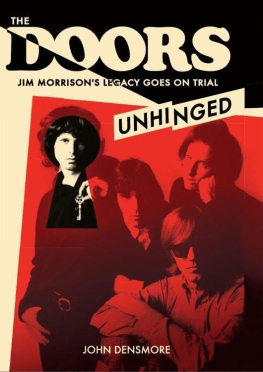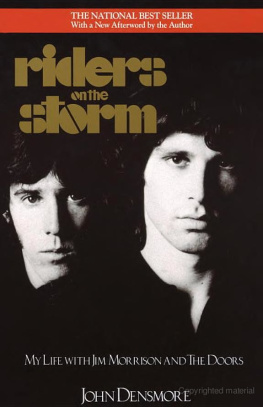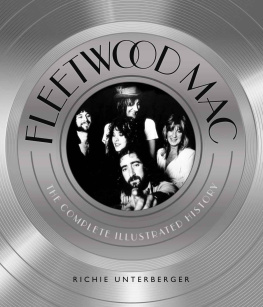The Doors FAQ
Series Editor: Robert Rodriguez
Other titles from the FAQ Series
Beach Boys FAQ: All Thats Left to Know About Americas Band
Jon Stebbins
Black Sabbath FAQ: All Thats Left to Know on the First Name in Metal
Martin Popoff
Fab Four FAQ: Everything Left to Know About the Beatles and More!
Stuart Shea and Robert Rodriguez
Fab Four FAQ 2.0: The Beatles Solo Years, 19701980
Robert Rodriguez
Led Zeppelin FAQ: All Thats Left to Know About the Greatest Hard Rock Band of All Time
George Case
Lucille Ball FAQ: Everything Left to Know About Americas Favorite Redhead
James Sheridan and Barry Monush
Pink Floyd FAQ: Everything Left to Know and More!
Stuart Shea
Three Stooges FAQ: Everything Left to Know About the Eye-Poking, Face-Slapping, Head-Thumping Geniuses
David J. Hogan
U2 FAQ: Anything Youd Ever Want to Know About the Biggest Band in the World and More!
John D. Luerssen
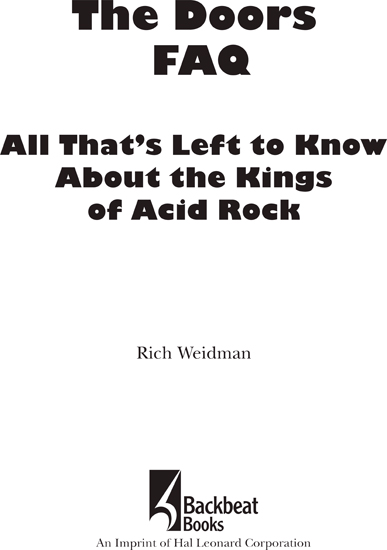
Copyright 2011 by Rich Weidman
All rights reserved. No part of this book may be reproduced in any form, without written permission, except by a newspaper or magazine reviewer who wishes to quote brief passages in connection with a review.
Published in 2011 by Backbeat Books
An Imprint of Hal Leonard Corporation
7777 West Bluemound Road
Milwaukee, WI 53213
Trade Book Division Editorial Offices
33 Plymouth St., Montclair, NJ 07042
The FAQ series was conceived by Robert Rodriguez and developed with Stuart Shea.
Book design by Snow Creative Services
Library of Congress Cataloging-in-Publication Data
Weidman, Rich.
The Doors FAQ : all thats left to know about the kings of acid rock / Rich Weidman.
p. cm.
Includes .
ISBN 978-1-61713-017-5 (alk. paper)
1. Doors (Musical group) 2. Rock musiciansUnited StatesBiography. I. Title.
ML421.D66W45 2011
782.421660922dc23
[B]
2011033449
www.backbeatbooks.com
For Nadine
Contents
The Doors Through a New Lens
Were voyeurs to the Doors story, but were voyeurs by invitation; that started with the bands first album. Weve seen the Doors through their eyes, through the eyes of friends, through the eyes of professional journalists and biographers. Rarely have we seen them through the eyes of fans. In trying to pull all the separate pieces of the Doors puzzle together and make sense of their story, The Doors FAQ fills this void.
The Doors were always differentfrom their beginnings on Venice Beach where Jim Morrison sang Moonlight Drive to Ray Manzarek. What was otherwise a poetic song about love has the shocking ending of the lovers drowning. When the Doors graduated to the Sunset Strip, they didnt fit into a mold or anything resembling an L.A. sound or a Sunset Strip sound. Love, which was the biggest band on the strip (and a group the Doors aspired to be as big as, early on) was a folk-rock group, as were the Lovin Spoonful, and the Byrds; the Doors were trying to blow the other bands off the stage. They were rock n roll.
After they became one of the major groups of the day, they were still different. The Beatles had graduated from treacly love songs to flowery psychedelia. Like Jim Morrison, John Lennon was influenced by Arthur Rimbaud but in a more superficial way. The Beatles psychedelia was full of light, flowers, and love; the Apollonian, as Morrison or Nietzsche would say. The Rolling Stones may have come the closest with their occasional forays into the darkness such as Paint it Black or Gimme Shelter. As critic Richard Goldstein said, The Stones are for blowing your minds, the Doors are for after your mind is blown.
Despite the darkness, the Doors vision wasnt bleak or devoid of hope, especially on their early albums. If the Doors were in the bright midnight, they were still waiting for the sun. In The Crystal Ship, the narrator of the song is looking for a moment of bliss, and when his love dies, hed rather fly. Even The End isnt an absolute ending. The narrator of the drama is moving on, to a place where others cant follow. As late as Morrison Hotel, Morrison was still optimistic about the future. In Queen of the Highway, he sang soon to have offspring/start it all over. Whether or not this was a reference to any particular woman in his life is arguable, but Morrison was looking to the future and the creative possibilities it might offer. It wasnt until L.A. Woman that Morrisons world had finally become a city of night where a cold girl will kill you in a darkened room.
The Doors are one of the truly revolutionary groups of rock n roll. Listen to most lyrics by their contemporaries and youll find fairly traditionally themed songs. It was only long hair and volume that upset the over-thirty crowd. The Doors werent revolutionary in the political sense. The Doors changed rock n roll. While Morrison embraced some of the familiar tropes of 60s rock musicgirls, love, and carsin his hands those familiar themes become something different, mysterious, and altogether dangerous. Love becomes sex, an active passion, not an idealistic longing. In declarations such as love me two times/Im goin away or love me all night long, the meaning becomes apparent. Cars arent for cruising with your girlfriend or carrying your surfboard; they become vehicles to destinations unknown and possibly dangerous.
The Doors were a literary band. Most people attribute this to Jim Morrison being well read and taking their name from William Blake via Aldous Huxleys The Doors of Perception. Ray Manzarek has always said that the Doors were a synthesis of blues, jazz, classical music, and Beat poetry. Over the years Manzarek has ably demonstrated the musical origins of the Doors on CDs and videos. But their literary influences, beyond a few mentions of writers names or a Doors reading list, is rarely delved into by other books. But has any other rock group worn its literary influences on its sleeve like the Doors? What other band has included the English poetry of William Blake (some are born to sweet delight/some are born to endless night), early twentieth-century French novels (Journey to the End of the Night), aphorisms (blood will be born in the birth of a nation/blood is the rose of a mysterious union) to John Rechy and a city of night, and Nietzsches Birth of Tragedy, a veritable blueprint for the Doors.
Literature influenced the Doors lyrically but also personally. Jim Morrison became the personification of Jack Kerouacs hero of On the Road, a sideburned hero of the snowy West and one of those mad to live, mad to talk, mad to be saved, desirous of everything at the same time, the ones who never yawn or say a commonplace thing, but burn, burn, burn Morrison became the rock stars idea of a rock star, leonine looks in a halo of hair and leather pants. Forty-five years later weve seen endless copies and variations on Morrisons model. His stage attitude and slouch make him the progenitor of punk rock. The Doors as a whole became a model for bands to come like the Screaming Trees, Nirvana, and Pearl Jam.
By the late 70s the Doors were facing the obscurity that had overtaken many of their contemporaries. The first flash of 70s resurrection came with An American Prayer, Morrisons poems recorded in 69 and 70. Later the surviving Doors added music, but the poetry of Morrison and the music of the Doors wasnt well received in the age of disco. Then came the almost simultaneous hits of Apocalypse Now and the Jerry Hopkins, Danny Sugerman biography of Morrison,

